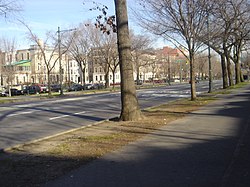| Revision as of 03:00, 28 August 2007 editJim.henderson (talk | contribs)Autopatrolled, Event coordinators, Extended confirmed users, IP block exemptions, Pending changes reviewers, Rollbackers72,742 edits Undid revision 153301224 by 4.237.210.206 Misspelled, miscapitalized, trivial and anonymous← Previous edit | Revision as of 03:06, 28 August 2007 edit undoPinchasC (talk | contribs)8,782 edits 770 Eastern Parkway and the Jewish Children's MuseumNext edit → | ||
| Line 25: | Line 25: | ||
| </blockquote> | </blockquote> | ||
| In addition to Grand Army Plaza and Prospect Park, other attractions and notable buildings along Eastern Parkway include the ] central branch, the ], |
In addition to Grand Army Plaza and Prospect Park, other attractions and notable buildings along Eastern Parkway include the ] central branch, the ], the ], ] and the ]. The parkway is the route of the ], a festive annual celebration taking place around ]. | ||
| ==Notes== | ==Notes== | ||
Revision as of 03:06, 28 August 2007
- This article refers to Eastern Parkway in Brooklyn, New York: there is also an Eastern Parkway in Louisville, Kentucky, also designed by the firm of Frederick Law Olmsted.
| Eastern Parkway | |
| U.S. National Register of Historic Places | |
 A view of Eastern Parkway near New York Avenue in Crown Heights. A view of Eastern Parkway near New York Avenue in Crown Heights. | |
| Location | New York, NY |
|---|---|
| Built | 1870 |
| Architect | Frederick Law Olmsted; Calvert Vaux |
| NRHP reference No. | 83001689 |
| Added to NRHP | September 26, 1983 |

.
Eastern Parkway is a street that runs through a portion of the New York City borough of Brooklyn. The road begins at Grand Army Plaza and extends east, running parallel to Atlantic Avenue, along the crest of the morraine that separates northern from southern Long Island, to Ralph Avenue. There, it turns to the northeast until it terminates at Evergreen Cemetery .
The section between Grand Army Plaza and Ralph Avenue consists of a central bidirectional avenue of six lanes, two small parallel side streets, and several medians with trees, benches, and paths for pedestrians and cyclists. The bike paths are part of the Brooklyn-Queens Greenway which runs through Prospect Park to Ocean Parkway, and east through Forest Park, Queens. East of Ralph Avenue, the parkway is reduced to four lanes, heading in a northeast direction towards the Jackie Robinson Parkway.
According to the New York City Department of Parks and Recreation, Eastern Parkway:
"the world's first parkway, was conceived by Frederick Law Olmsted and Calvert Vaux in 1866. The term parkway was coined by these designers as a landscaped road built expressly for 'pleasure-riding and driving' or scenic access to Prospect Park (also designed by Olmsted and Vaux). To these ends, commerce was restricted. The parkway was constructed from Grand Army Plaza to Ralph Avenue (the boundary of Brooklyn) between 1870 and 1874. Olmsted and Vaux intended Eastern Parkway to be the Brooklyn nucleus of an interconnected park and parkway system for the New York area. The plan was never completed but their idea of bringing the countryside into the city influenced the construction of major parks and parkways in cities throughout the United States."
In addition to Grand Army Plaza and Prospect Park, other attractions and notable buildings along Eastern Parkway include the Brooklyn Public Library central branch, the Brooklyn Museum, the Brooklyn Botanical Gardens, 770 Eastern Parkway and the Jewish Children's Museum. The parkway is the route of the West Indian Day Parade, a festive annual celebration taking place around Labor Day.
Notes
- "National Register Information System". National Register of Historic Places. National Park Service. 2007-01-23.
- Google Maps
- New York City Department of Parks and Recreation
Eastern Parkway Strolling http://thecrownheightser.blogspot.com/2007/05/eastern-parkway-strolling-in-season.html
Categories: